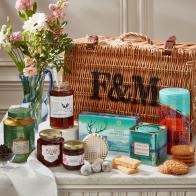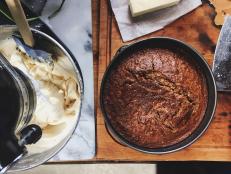Flour 101

Renee Comet, Renee Comet
From bread to biscuits, cookies to cakes, baking is the art of turning flour into (delicious) food. Flour — finely milled wheat or other grains — lends structure to baked goods, but different baked goods demand different structural supports. Choose the right flour for the right task and you're a long way toward baking success. Choose the wrong flour and you're courting trouble.
Protein content is the primary differentiator in flours. High-protein wheat varieties (10 to 14 percent protein) are classed as "hard wheat." Low-protein wheats (5 to 10 percent) are known as "soft wheat." Simply put: More protein equals more gluten equals more strength. And more strength translates into more volume and a chewier texture. Doughs made from high-protein flours are both more elastic (stretch further) and more extensible (hold their shape better) — desirable qualities in bread and many other yeasted products where a firm structure is paramount, but undesirable in pastries and cakes, where the goal is flakiness or tenderness.
Unless labeled "whole-wheat," all flour is white flour: that is, milled from the starchy, innermost part of the wheat kernel, known as the endosperm.
All-Purpose Flour: If a recipe calls simply for "flour," it's calling for all-purpose flour. Milled from a mixture of soft and hard wheat, with a moderate protein content in the 10 to 12 percent range, all-purpose flour is a staple among staples. While not necessarily good for all purposes, it is the most versatile of flours, capable of producing flaky pie crusts, fluffy biscuits and chewy breads. A-P flour is sold bleached or unbleached; the two are largely interchangeable, but it's always best to match your flour to your recipe.
Cake Flour: The flour with the lowest protein content (5 to 8 percent). The relative lack of gluten-forming proteins makes cake flour ideal for tender baked goods, such as cakes (of course), but also biscuits, muffins and scones. Cake flour is generally chlorinated, a bleaching process that further weakens the gluten proteins and, just as important, alters the flour's starch to increase its capacity to absorb more liquid and sugar, and thus ensure a moist cake.
Pastry Flour: An unbleached flour made from soft wheat, with protein levels somewhere between cake flour and all-purpose flour (8 to 9 percent). Pastry flour strikes the ideal balance between flakiness and tenderness, making it perfect for pies, tarts and many cookies. To make your own pastry flour, mix together 1 1/3 cups A-P flour and 2/3 cup cake flour.
Bread Flour: With a protein content of 12 to 14 percent, bread flour is the strongest of all flours, providing the most structural support. This is especially important in yeasted breads, where a strong gluten network is required to contain the CO2 gases produced during fermentation. The extra protein doesn't just make for better volume and a chewier crumb; it also results in more browning in the crust. Bread flour can be found in white or whole wheat, bleached or unbleached. Unbleached all-purpose flour can generally be substituted for bread flour with good results.
Self-Rising Flour: Flour to which baking powder and salt have been added during milling. Long a Southern staple, self-rising flour is generally made from the low-protein wheat traditionally grown in the South. It's best for tender biscuits, muffins, pancakes and some cakes. Self-rising flour is best stored tightly wrapped in its original box and used within six months of purchase — longer than that and the baking powder in it begins to lose its oomph.
To make your own self-rising flour, combine 1 cup pastry flour with 1 1/2 teaspoons baking powder and 1/4 teaspoon salt.
Whole-Wheat Flour: During milling, the wheat kernel is separated into its three components: the endosperm, the germ (the embryo) and the bran (the outer coating). In whole-wheat flours, varying amounts of the germ and bran are added back into the flour. Whole-wheat flour tends to be high in protein, but its gluten-forming ability is compromised by the bran and germ — just one of the reasons whole-wheat flour tends to produce heavier, denser baked goods.
In most recipes, whole-wheat flour can be substituted for up to half of the all-purpose flour. Because wheat germ is high in oils prone to rancidity, whole-wheat flour is far more perishable than white. Store it for up to three months at cool room temperature, and then transfer it to the freezer.
Gluten-Free Flours: There is a wide variety of gluten-free flours available today, made from all sorts of grains, nuts and starches. Some of the most widely available are based on rice flour blended with tapioca and potato starch. A small proportion of xanthan gum is sometimes added to help simulate the chewiness normally associated with gluten. Consult the specific recipe or packaging for information on how to substitute gluten-free flour for wheat flour in your favorite baking recipes.























.jpg.rend.hgtvcom.231.174.suffix/1681323015319.jpeg)








